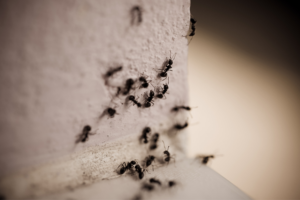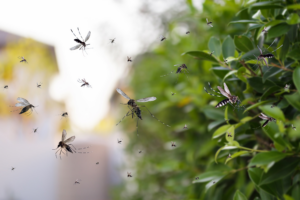Termites are a year-round problem for homeowners in San Diego, but there are specific times when these wood-destroying pests become more active. Knowing when termite season occurs, the warning signs of an infestation, and how to prevent termites can help you protect your property from costly damage. Let’s dive into when termite season is in San Diego, the common termite species in the area, and how you can keep your home termite-free.
When Is Termite Season in San Diego?
Termite season in San Diego typically spans from early spring through late fall, with swarming season peaking during early fall and after the rainy season. During these periods, reproductive termites, also known as alates, leave their existing colonies to establish new ones. Swarming termites are winged and are often the first visible sign that you may have a termite problem on your property.
Termite swarming season can vary slightly depending on the species. In San Diego, termites are active year-round due to the mild climate, but they are especially aggressive and visible during spring and early fall when environmental conditions—like humidity and warmer temperatures—are ideal for mating.
Common Termite Species in San Diego
San Diego is home to two main types of termites: drywood termites and subterranean termites. Understanding the differences between these two species can help you identify which type may be causing issues in your home.
- Drywood Termites: These termites thrive in dry wood and are common in coastal areas like San Diego. They don’t require soil contact and can live entirely within the wood they infest. Drywood termites are notorious for creating their colonies in attics, furniture, and structural wood within homes.
- Subterranean Termites: This species is much more aggressive and is considered the most destructive type of termite. Subterranean termites live in underground colonies and require soil moisture to survive. They create mud tubes to travel between their colony and a food source, often the wooden structure of a home.
Signs of Termite Activity in San Diego
Recognizing the signs of termite activity early is critical to preventing a full-blown infestation. Here are some warning signs that termites may have already invaded your home:
- Swarming termites: If you notice winged termites, especially during early fall, it is a clear indicator that a colony is nearby and looking to establish new nests. Swarming usually occurs after rain, which softens the ground for subterranean termites to move.
- Discarded wings: After termites swarm and mate, they shed their wings. If you find piles of discarded wings near windows, doors, or other entry points, it’s likely that termites have already settled in.
- Mud tubes: Subterranean termites build mud tubes to travel between their colonies and food sources. These small, pencil-sized tubes are often found on foundation walls, crawl spaces, or basement walls.
- Wood damage: Termites eat wood from the inside out, leaving a honeycomb-like pattern or hollow-sounding areas when tapped. If you notice sagging floors, cracked walls, or damaged wood, termites could be to blame.
- Frass (termite droppings): Drywood termites leave behind small piles of wood-colored droppings known as frass. These piles may look like sawdust and are typically found near wood structures.
Tips to Prevent Termites in San Diego
Preventing termites from invading your home is much easier than dealing with a termite infestation. Here are some tips to prevent termites from wreaking havoc on your property:
- Seal cracks and gaps: Inspect the exterior of your home for cracks, gaps, or holes where termites could enter. Pay special attention to areas around windows, doors, and the foundation.
- Eliminate moisture sources: Since termites, particularly subterranean termites, are attracted to moisture, it’s important to fix any leaking pipes, faucets, or roof damage. Keep gutters clean to prevent water from accumulating near your home’s foundation.
- Remove wood-to-soil contact: Ensure that wooden structures like decks, fences, and support beams do not touch the soil directly. Consider using concrete supports to lift wood off the ground.
- Regular termite inspections: Schedule termite inspections with a licensed termite control company to catch termite activity early. Regular inspections are essential to staying ahead of potential infestations, especially during peak termite season.
- Treat wooden structures: Apply termite-resistant treatments to wooden elements of your home, particularly in areas that are prone to moisture or direct soil contact.
Termite Treatment Options in San Diego
If you discover a termite infestation in your home, various treatment options are available to eliminate these pests effectively. One of the most common methods is fumigation, particularly for drywood termites. Fumigation involves sealing the home and filling it with a gas that penetrates deep into the wood, killing termites throughout the structure. This method is highly effective for large infestations that are hard to reach. For subterranean termites, treatments typically involve the use of liquid termiticides or baiting systems. Liquid treatments create a protective barrier around your home, preventing termites from entering and killing any that come into contact with it. Baiting systems, on the other hand, use strategically placed bait stations around the property to lure termites, which then carry the poison back to their colony, eventually eliminating it. Both methods can be highly effective, and a licensed termite control company will help determine the best solution based on the type and severity of your termite problem. Regular maintenance and follow-up inspections are essential to ensure your home remains protected.
Call a Professional Termite Control Company in San Diego
If you suspect that termites are active in or around your home, it’s critical to act quickly. A termite infestation can cause significant structural damage if left untreated. Professional termite control companies offer expert inspections, treatments, and preventative solutions to keep your home safe from these destructive pests.
Don’t wait for termites to cause damage. If you’re in San Diego and have noticed any signs of termite activity, contact a local termite control company today to schedule an inspection. Early detection and treatment are key to keeping your home termite-free year-round!



